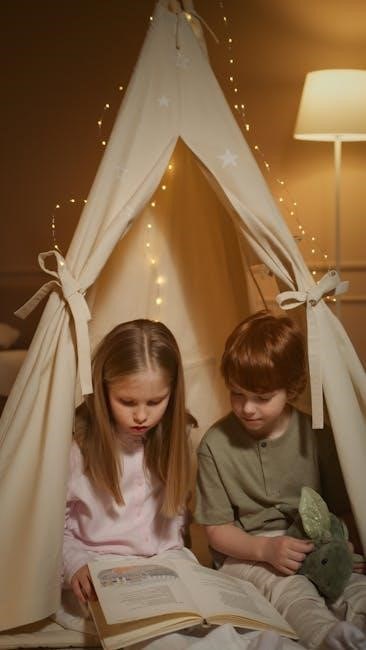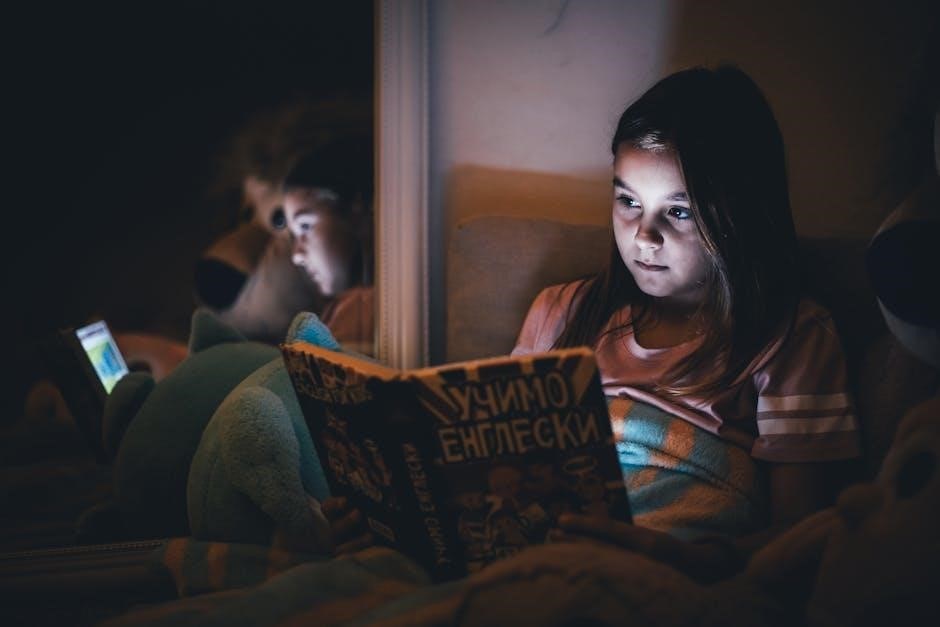The classic tale of Goldilocks and the Three Bears remains a beloved story, teaching moral lessons about respect and consequences through its timeless narrative and memorable characters.
Overview of the Three Bears Story
The story of Goldilocks and the Three Bears is a timeless fairy tale about a curious girl who encounters a bear family’s cottage in the forest. The narrative revolves around Goldilocks’ unauthorized entry into the bears’ home, where she samples their porridge, sits in their chairs, and sleeps in Baby Bear’s bed. Her actions lead to discovery and a lesson about respect for others’ property. The tale, originally penned by Robert Southey, has evolved into various adaptations, making it a staple in children’s literature. Its simple yet engaging plot, combined with moral lessons, continues to captivate audiences of all ages.
Importance of the Story in Children’s Literature
The story of Goldilocks and the Three Bears holds significant importance in children’s literature as it imparts essential moral lessons through an engaging narrative. It teaches children the value of respect for others’ property and the consequences of curiosity and mischief. The tale’s simple and relatable plot makes it an effective tool for early literacy development, helping young readers understand cause-and-effect relationships. Additionally, its memorable characters and repetitive elements enhance storytelling, making it a favorite for generations. The story’s adaptability to various formats, including PDF versions, ensures its accessibility and enduring appeal in modern education and entertainment.

Origins of the Story
The tale of Goldilocks and the Three Bears was first published by Robert Southey in 1837, evolving from earlier oral traditions. Its origins reflect folklore influences, making it a timeless classic.
Historical Background and First Publications
The story of Goldilocks and the Three Bears was first published by Robert Southey in 1837 under the title The Story of the Three Bears. Southey’s version introduced the core elements of the narrative, including the bears’ porridge and Goldilocks’ curiosity. The tale evolved from oral folklore traditions, with variations emerging over time. Initially, the story lacked Goldilocks, featuring an old woman instead, but her character was later popularized in the 20th century. The story’s earliest publications laid the foundation for its widespread appeal, making it a classic fairy tale enjoyed across generations. Its enduring popularity has led to numerous adaptations and interpretations.
Evolution of the Narrative Over Time
The story of Goldilocks and the Three Bears has undergone significant changes since its first publication. Initially, the tale featured an old woman rather than Goldilocks, with Robert Southey’s 1837 version being one of the earliest written records. Over time, Goldilocks replaced the old woman, and her character became central to the narrative. The story’s moral lessons, such as respect for others’ property, were emphasized in later adaptations. Modern retellings have softened the bears’ portrayal, making them more friendly and less fearsome. The story’s enduring appeal has led to numerous adaptations in films, stage plays, and digital formats, ensuring its relevance for new generations. These changes reflect cultural shifts while preserving the core themes of curiosity, consequence, and redemption.

Main Characters
The story features Papa Bear, Mama Bear, and Baby Bear, a loving family, alongside Goldilocks, a curious girl whose actions drive the narrative’s conflict and moral lessons.
Papa Bear, Mama Bear, and Baby Bear
The three bears are central characters in the story, each with distinct personalities. Papa Bear is portrayed as strong and gentle, often showing leadership. Mama Bear is caring and nurturing, ensuring the family’s well-being. Baby Bear is playful and innocent, representing curiosity and vulnerability. Together, they embody a loving family dynamic, emphasizing cooperation and unity. Their home and routine showcase a sense of order and normalcy, which contrasts with the chaos introduced by Goldilocks. The bears’ reactions to her actions highlight themes of respect for property and the consequences of interference, making them relatable and memorable characters in the tale.
Goldilocks and Her Role in the Story
Goldilocks is the curious and mischievous protagonist whose actions drive the story’s conflict. She wanders into the bears’ house, sampling their porridge, sitting in their chairs, and sleeping in Baby Bear’s bed. Her curiosity and disregard for others’ property lead to chaos, making her a pivotal figure in the narrative. Goldilocks’ character serves as a lesson about the consequences of curiosity and the importance of respecting others’ belongings. Her actions contrast with the bears’ harmonious family life, highlighting themes of responsibility and morality. This makes her a memorable and impactful character in the tale, teaching children valuable life lessons.

Plot Summary
The story begins with the three bears leaving their porridge to cool. Goldilocks discovers their house, samples the porridge, sits in their chairs, and sleeps in Baby Bear’s bed. Chaos ensues when the bears return.
The Bears’ Morning Routine
The story begins with the three bears preparing their breakfast. Papa Bear, Mama Bear, and Baby Bear each have their own bowl of porridge. Papa Bear’s porridge is too hot, Mama Bear’s is too cold, and Baby Bear’s is just right; After tasting their porridge, they decide to let it cool and take a walk in the forest. This morning routine sets the stage for the unexpected arrival of Goldilocks, whose curiosity and mischief lead to chaos in their peaceful home. The bears’ simple, orderly morning highlights their harmonious family life before the disruption caused by the curious visitor.
Goldilocks’ Arrival and Exploration of the House
While the three bears were away, Goldilocks wandered into their forest cottage, driven by curiosity. She knocked on the door, and when no one answered, she let herself in. Inside, she discovered the bears’ porridge and tasted each bowl, declaring Baby Bear’s “just right.” Her exploration continued as she sat in their chairs, breaking Baby Bear’s chair, and later climbed upstairs to sleep in Baby Bear’s bed. Goldilocks’ mischief and curiosity led her to snoop through every corner of the house, unaware of the chaos she was creating. Her actions set the stage for the bears’ eventual return and the story’s climactic confrontation.
The Consequences of Her Actions
Goldilocks’ curiosity and mischief led to significant consequences. After tasting the porridge, breaking Baby Bear’s chair, and sleeping in his bed, she was startled by the bears’ return. Frightened, she fled the house, leaving behind a trail of chaos. The story highlights the repercussions of her actions, teaching children about responsibility and respect for others’ property. Her hasty departure serves as a moral lesson, emphasizing the importance of considering the impact of one’s behavior on others.

Themes and Moral Lessons
The story emphasizes respect for others’ property, consequences of curiosity and mischief, and the importance of family and cooperation, providing timeless moral lessons for children.
Respect for Others’ Property
The story of Goldilocks and the Three Bears vividly illustrates the importance of respecting others’ property. Goldilocks’ unauthorized entry into the bears’ house and her subsequent actions—eating their porridge, sitting in their chairs, and sleeping in Baby Bear’s bed—highlight the consequences of disregarding boundaries. Her curiosity and lack of restraint lead to disruption and dissatisfaction for the bear family. This moral lesson teaches children the value of respecting others’ belongings and understanding that taking something without permission can harm others. The story serves as a timeless reminder to appreciate boundaries and prioritize kindness in interactions with others’ property.
Consequences of Curiosity and Mischief
Goldilocks’ curiosity and mischievous actions in the story of Goldilocks and the Three Bears lead to significant consequences. Her unauthorized exploration of the bears’ home results in disruption and damage, such as breaking Baby Bear’s chair and eating their porridge. When the bears discover her, Goldilocks faces their anger and must flee, learning a hard lesson about boundaries. This narrative emphasizes how unchecked curiosity and reckless behavior can lead to harm for oneself and others. The story teaches children the importance of self-control and respecting others’ space, highlighting the negative outcomes of impulsive actions.
The Importance of Family and Cooperation
The story of Goldilocks and the Three Bears highlights the significance of family bonds and cooperation. The three bears—Papa Bear, Mama Bear, and Baby Bear—demonstrate a strong sense of unity as they work together to maintain their home and resolve conflicts. Their cooperative efforts, such as preparing meals and addressing challenges, show how family members support one another. This theme emphasizes the value of teamwork and mutual respect within a family structure. The bears’ ability to rebuild and move forward after Goldilocks’ intrusion further illustrates the strength of their collective resolve and the importance of standing together as a family.
Digital Versions and PDF Availability
Digital versions of Goldilocks and the Three Bears are widely available as PDFs, offering convenient access to the classic tale for readers of all ages worldwide.
How to Find the Story in PDF Format
To locate Goldilocks and the Three Bears in PDF format, use specific search terms like “Goldilocks and the Three Bears PDF” or “Three Bears story PDF download.” Utilize quotation marks for exact matches and explore trusted websites or digital libraries. Refine your search by adding keywords such as “free,” “illustrated,” or “children’s story” to find suitable versions. Ensure to verify the source for reliability and quality. This method helps in quickly accessing the tale in a convenient digital format, ideal for reading or sharing with others.
Benefits of Digital Versions for Modern Readers
Digital versions of Goldilocks and the Three Bears offer convenience and accessibility for modern readers. PDF formats allow stories to be easily shared, downloaded, and read on various devices, making them ideal for on-the-go access. Interactive features in some editions, such as clickable links or animations, enhance engagement, especially for children. Additionally, digital versions reduce physical storage needs and are environmentally friendly. They also enable quick searches and bookmarking, improving the reading experience. With digital formats, the timeless tale remains accessible to new generations, blending tradition with modern technology for seamless storytelling.
Interactive Features in Some PDF Editions
Certain PDF editions of Goldilocks and the Three Bears include interactive features that enhance the reading experience. These may range from clickable links to animations and sound effects, bringing the story to life. Some versions offer quiz questions or word searches to engage young readers and test their understanding. Additionally, interactive elements like flippable pages and zoom options provide a user-friendly interface. These features make the story more immersive and accessible, especially for children. They also cater to modern readers who appreciate multimedia-rich content, blending tradition with technology for a captivating experience. Such editions ensure the tale remains engaging in the digital age.

Educational Uses
Goldilocks and the Three Bears is widely used in classrooms for teaching moral values, language skills, and literacy. Its simple narrative aids in engaging young learners effectively;
Teaching Moral Values Through the Story
The story of Goldilocks and the Three Bears serves as a powerful tool for teaching moral values to children. It emphasizes the importance of respecting others’ property, as Goldilocks’ unauthorized entry and actions lead to consequences. The narrative also highlights the value of honesty and responsibility, encouraging children to think about the impact of their actions. Additionally, the story teaches patience and cooperation, as the bears work together to resolve the disruption caused by Goldilocks. These lessons are conveyed through a relatable and engaging storyline, making it an effective resource for moral education in both homes and classrooms.
Using the Story for Language and Literacy Development
The story of Goldilocks and the Three Bears is a valuable resource for language and literacy development. Its simple, repetitive structure makes it ideal for early readers, helping them recognize patterns and build vocabulary. The narrative’s engaging dialogue and clear cause-and-effect relationships enhance comprehension skills. Interactive PDF versions of the story often include features like clickable words or audio narration, which can aid in pronunciation and fluency. Additionally, the story’s moral lessons provide opportunities for discussions that promote critical thinking and language expression. This makes it a versatile tool for educators and parents aiming to foster a love for reading and improve literacy skills in children.
Cultural Impact
The story of Goldilocks and the Three Bears has significantly influenced popular culture, with numerous adaptations in film, television, and art, reflecting its enduring appeal in various digital formats.
Influence on Popular Culture and Media
The tale of Goldilocks and the Three Bears has become a cultural phenomenon, inspiring countless adaptations in film, television, and advertising. Its characters and plot have been referenced in various media, from animated series to commercials, making it a recognizable narrative worldwide. The story’s themes and iconic elements, such as the porridge and the broken chair, are frequently used to convey moral lessons or humor in modern contexts. Additionally, its influence extends to education, with the story being incorporated into teaching materials and digital resources, ensuring its relevance across generations and platforms.
Adaptations in Film, Theater, and Art
The story of Goldilocks and the Three Bears has been adapted into numerous films, stage plays, and artistic interpretations. Animated films and live-action movies have brought the characters to life, while theater productions have reimagined the narrative with creative dialogue and performances. In art, the tale has inspired illustrations, paintings, and sculptures that capture its whimsical essence. These adaptations not only entertain but also reinterpret the story for new audiences, ensuring its timeless appeal. By exploring different mediums, the tale continues to resonate, offering fresh perspectives while retaining its original charm and moral lessons.
Modern Adaptations and Interpretations
The Three Bears story has been reimagined in various modern formats, including interactive digital books and animated series, offering fresh perspectives while retaining its timeless moral lessons.
Contemporary Retellings of the Classic Tale
Modern adaptations of Goldilocks and the Three Bears have breathed new life into the classic story, offering fresh perspectives while maintaining its timeless charm. Digital versions, such as interactive PDFs, incorporate vibrant visuals and engaging features, making the tale more accessible to today’s tech-savvy children. Some retellings introduce new characters or settings, like urban environments, to appeal to diverse audiences. Additionally, cultural reinterpretations have emerged, blending the story with global traditions and themes. These contemporary versions not only entertain but also teach modern lessons, such as empathy and self-control, while preserving the original moral core of the narrative.
Diverse Perspectives and New Characters
Contemporary adaptations of Goldilocks and the Three Bears often incorporate diverse perspectives, introducing new characters and cultural contexts to broaden the story’s appeal. Modern retellings may feature the bears as a multiracial family or Goldilocks as a character from a different cultural background. Some versions include additional characters, such as friends of the bears or other forest creatures, to enrich the narrative. These fresh interpretations allow readers to connect with the story on a more personal level while maintaining the core moral lessons. Digital PDF editions often highlight these innovations, making the tale relevant to a global audience;
The Three Bears Story remains a timeless tale, offering moral lessons and entertainment for generations. Its adaptability to digital formats ensures its enduring appeal in the modern age.
Enduring Appeal of the Three Bears Story
The story’s enduring appeal lies in its timeless themes, memorable characters, and simple narrative. Goldilocks’ curiosity and the bears’ unity resonate across generations, teaching lessons on respect and consequences. Its availability in PDF formats and adaptability to modern media ensure its relevance in the digital age.
Its Relevance in the Digital Age
The Three Bears story remains highly relevant in the digital age, thanks to its timeless themes and adaptability to modern formats. Digital versions, including PDFs, offer convenient access to the tale, making it easily shareable and accessible across devices. Interactive features in some PDF editions enhance engagement, especially for young readers. The story’s moral lessons about respect and consequences continue to resonate, while its availability in digital formats ensures its enduring popularity. This blend of tradition and innovation keeps the story fresh and accessible for new generations of readers.
